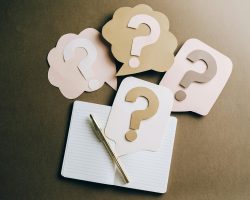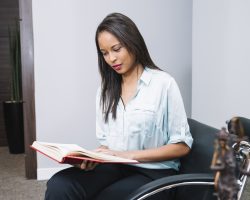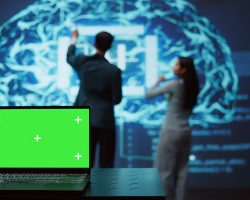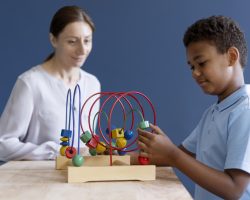Tune Into Non-Verbal Learning Disabilities with Linda Karanzalis, MS, BCCS
 Natural ways to support people with Nonverbal Learning Disabilities (NVLD) are becoming more common as awareness of the condition increases. Knowing what helps a person affected by NVLD to perform according to their potential, rather than being limited by the difficulties caused by the condition, can be the difference between feeling overwhelmed and feeling empowered.
In her new book, “Misnamed, Misdiagnosed and Misunderstood; Recognizing and Coping with NVLD (Nonverbal Learning Disorder) from Childhood through Adulthood” she offers a frank account of her own struggles with academics, jobs, and relationships. She helps people sift through useless strategies to find natural solutions and helps them understand the diagnosis while discovering their strengths. Through strategies, stories, and checklists, Linda empowers those with a “differently hardwired brain” to achieve their goals.
Linda is a role model, offering understanding, inspiration, and tools to NVLD’ers and those who love them.
New York Times bestselling author of “Driven to Distraction” Dr. Edward Hallowell describes Linda’s book as, “Vivid, compelling…Karanzalis replaces suffering, misunderstanding, and frustration with triumph, clarity, and success for the millions of people who have NVLD.”
Natural ways to support people with Nonverbal Learning Disabilities (NVLD) are becoming more common as awareness of the condition increases. Knowing what helps a person affected by NVLD to perform according to their potential, rather than being limited by the difficulties caused by the condition, can be the difference between feeling overwhelmed and feeling empowered.
In her new book, “Misnamed, Misdiagnosed and Misunderstood; Recognizing and Coping with NVLD (Nonverbal Learning Disorder) from Childhood through Adulthood” she offers a frank account of her own struggles with academics, jobs, and relationships. She helps people sift through useless strategies to find natural solutions and helps them understand the diagnosis while discovering their strengths. Through strategies, stories, and checklists, Linda empowers those with a “differently hardwired brain” to achieve their goals.
Linda is a role model, offering understanding, inspiration, and tools to NVLD’ers and those who love them.
New York Times bestselling author of “Driven to Distraction” Dr. Edward Hallowell describes Linda’s book as, “Vivid, compelling…Karanzalis replaces suffering, misunderstanding, and frustration with triumph, clarity, and success for the millions of people who have NVLD.”
What is Nonverbal Learning Disability
Non-Verbal Learning Disability, while not yet part of the Diagnostic and Statistical Manual of Mental Disorders (DSM), NVLD is receiving more attention lately. At last, many people with this condition are getting answers to common struggles they face daily. Oftentimes, people with NVLD can be misdiagnosed with ADHD or autism. ADHD and autism are formal diagnoses and have many similar ways of manifesting themselves in the daily life of those with NVLD. Still, NVLD is very different from either of the other two diagnoses. Those differences can be seen distinctly in brain biology, indicating that different parts of the brain area are affected by each of these three diagnoses. After conducting a study about NVLD at Michigan State University, one researcher states, “using MRI scans of the participants’ brains, the researchers found that children with NVLD have smaller splenia than those with high-functioning autism and ADHD. The splenia is a part of the corpus callosum that connects the left and right hemisphere. The splenium is part of the corpus callosum, a thick band of fibers in the brain that connects the left and right hemispheres and facilitates communication between the two sides. Interestingly, this posterior part of the corpus callosum serves the areas of the brain related to visual and spatial functioning. NVLD also can be seen as a right-hemisphere weakness within the brain. But what does that all mean in daily life?
The splenium is part of the corpus callosum, a thick band of fibers in the brain that connects the left and right hemispheres and facilitates communication between the two sides. Interestingly, this posterior part of the corpus callosum serves the areas of the brain related to visual and spatial functioning. NVLD also can be seen as a right-hemisphere weakness within the brain. But what does that all mean in daily life?
Strengths and Weaknesses of NVLD
The brain is made up of different regions, each one responsible for various skills and tasks. In general, language skills are in the left side of the brain. The right side of the brain controls attention, memory, reasoning, and problem-solving. Knowing that the right side of the brain is most affected by NVLD, it is easy to understand some of the more common strengths and weaknesses one would experience. A person with NVLD typically has excellent verbal communication (since the left side of the brain is fully functioning) and oftentimes a very high IQ. In conjunction with that, difficulties arise with visual-spatial processing, executive functioning (planning and prioritizing), recognizing and processing nonverbal social communication cues (facial expressions, body language, tone of voice), academics, motor skills, social-emotional learning, higher-order thinking (forming conclusions from facts), and mathematical concepts. Many of these strengths and weaknesses can seem counterintuitive and frustrating to someone who doesn’t understand NVLD, making them wonder: How can an articulate, well-spoken person not feel confident in social situations? Why can’t a person with a high IQ perform well in school?
It has been estimated that people with NVLD cannot process a significant amount (some researchers say as high as 93 percent) of nonverbal communication. Nonverbal communication (body language, tone of voice, gestures) changes the meaning of spoken words, causing those with NVLD to continually misunderstand others. Self-acknowledgment and education about NVLD go hand in hand with other tools to move forward.
– Linda Karanzalis, MS, BCCS
People with NVLD often struggle to find their footing in areas such as; social situations, school performance, and overall self-esteem when they don’t have access to information and supports that allow them to understand the disorder. Discovering natural ways to improve their ability to function can improve confidence and overall joy in life.
Natural Ways to Support People With NVLD
Non-invasive, natural, and easily accessible support tools are the best way to help anyone affected by NVLD to understand, embrace, and begin thriving with NVLD. It is possible and can be done by integrating a couple of simple practices: Education To understand something is to feel empowered to address it and thrive. The same holds true for a person with NVLD. Reading about other’s experiences, or diving into formal research can be empowering to help people with NVLD finally understand what it is they are dealing with and how to navigate it. The Listening Program® Linda is a Certified Provider of The Listening Program (TLP) and incorporates music listening therapy alongside her approach to achieving optimum brain health and functioning. In her book, she shares, “TLP is a research-based program that helps those with NVLD and NDs with executive function, anxiety, focus, and academics.” People are beginning to realize how effective brain training with music truly is. The brain responds best to structure and organization presented in short sessions over time. The beauty of music is that it is the perfect balance presented in an enjoyable experience. The brain can change with the right stimulation. Numerous studies have found that music stimulates more brain areas than any other known stimulus. For music to make meaningful long-term changes, it should be scientifically created to improve brain health and functioning. TLP uses neuroacoustically modified music with immediate, short-term, and lasting long-term improvements in brain function for people of all ages and abilities. For people with NVLD, it can be a great way to naturally improve right hemisphere functioning in the brain, resulting in better executive function, academic performance, and more. Thanks to the advanced spatial surround technologies within The Listening Program, listeners experience movement of the music and individual instruments to evoke the spatial functions of the ear-brain connection. It further helps synchronize the brain’s left and right hemispheres, improving inter-hemispheric communication and brain integration. Spatial surround training increases the feeling of emotional safety and connection to the world.
We are excited about this gentle yet stimulating training to offer a constant spatial reference to help people with NVLD better understand their position in time and space for a feeling of attunement, safety, and connection to the world. The progression of the compositions gradually trains parts of the brain to create new neural connections to improve executive function skills, motor skills, academic skills, and more.
It’s an effective way to train the brain, so those with NVLD can more quickly monitor and adapt their behavior to stay calm, especially when encountering learning challenges, obstacles, or when plans suddenly change. As a result, they become more flexible and enjoy creative problem-solving skills under pressure or when faced with something new.
As their performance improves, they will likely feel more confident, independent, and capable. There are many observable changes in their daily life as they become more responsible and productive. They may become natural leaders, work well with peers, and feel motivated to reach a shared goal.
Having NVLD may not be easy as there are few ways to correctly identify it, but that doesn’t leave families and individuals without hope for a solution to address it naturally. Through education and The Listening Program, people are finding answers and ways to improve their abilities to function better in social settings, school, jobs, and life.
Thanks to the advanced spatial surround technologies within The Listening Program, listeners experience movement of the music and individual instruments to evoke the spatial functions of the ear-brain connection. It further helps synchronize the brain’s left and right hemispheres, improving inter-hemispheric communication and brain integration. Spatial surround training increases the feeling of emotional safety and connection to the world.
We are excited about this gentle yet stimulating training to offer a constant spatial reference to help people with NVLD better understand their position in time and space for a feeling of attunement, safety, and connection to the world. The progression of the compositions gradually trains parts of the brain to create new neural connections to improve executive function skills, motor skills, academic skills, and more.
It’s an effective way to train the brain, so those with NVLD can more quickly monitor and adapt their behavior to stay calm, especially when encountering learning challenges, obstacles, or when plans suddenly change. As a result, they become more flexible and enjoy creative problem-solving skills under pressure or when faced with something new.
As their performance improves, they will likely feel more confident, independent, and capable. There are many observable changes in their daily life as they become more responsible and productive. They may become natural leaders, work well with peers, and feel motivated to reach a shared goal.
Having NVLD may not be easy as there are few ways to correctly identify it, but that doesn’t leave families and individuals without hope for a solution to address it naturally. Through education and The Listening Program, people are finding answers and ways to improve their abilities to function better in social settings, school, jobs, and life.


 Linda Karanzalis, MS
Linda Karanzalis, MS











